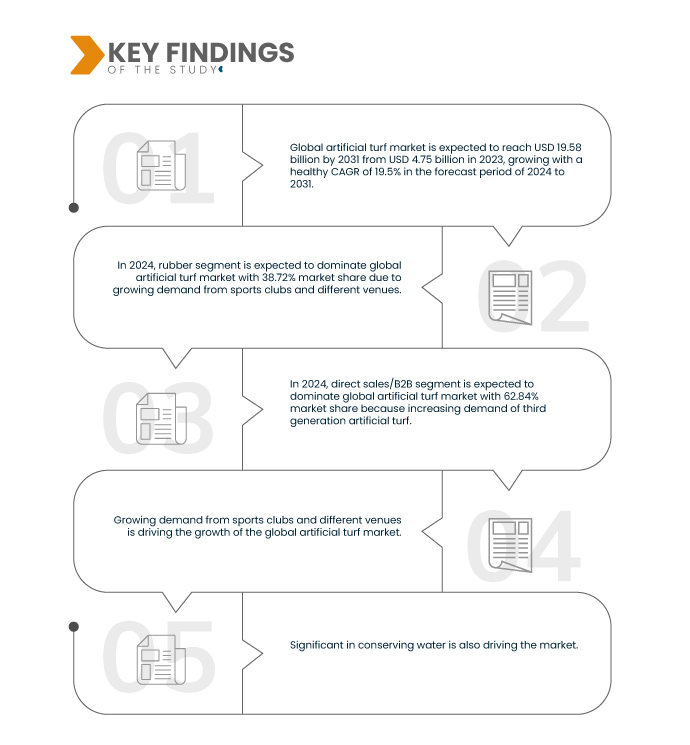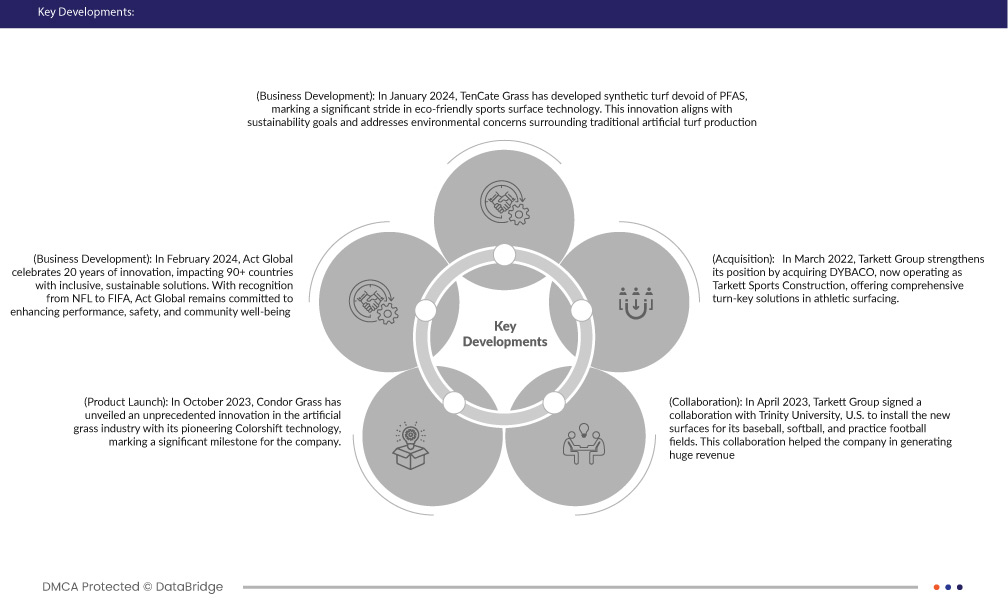The growing demand from sports clubs and different venues is driving the global artificial turf market. This demand is fueled by factors such as the need for durable and low-maintenance playing surfaces, as well as the desire to increase play hours. Artificial turf offers advantages such as longer lifespan compared to natural turf, lower maintenance costs, and higher resistance to wear and tear. However, there are also considerations regarding the disposal and recycling of artificial turf materials, which must be factored in every 10 years or so. Despite these challenges, the increasing demand from sports clubs and venues is expected to boost the global artificial turf market.
Access Full Report @ https://www.databridgemarketresearch.com/jp/reports/global-artificial-turf-market
Data Bridge Market Research analyses that the Global Artificial Turf Market is expected to reach a value of USD 19.58 billion by 2031 from 4.75 billion in 2023, growing at a CAGR of 19.5% during the forecast period 2024 to 2031.
Key Findings of the Study
Significant in Conserving Water
Artificial turf offers substantial environmental benefits, particularly in water conservation. In North America, it saves over three billion gallons of water annually, reduces smog pollution, and eliminates the need for almost a billion pounds of toxic fertilizers and pesticides. The industry has also recycled over 105 million tires. These benefits make artificial turf appealing for leisure spaces, benefiting millions of individuals, businesses, schools, and households. Furthermore, the industry continues to innovate, with synthetic turf fields saving about 5,000 gallons of water per year per full-sized field, totaling at least three billion gallons of water saved in 2010. Replacing natural grass with artificial turf also eliminates the need for watering lawns, which accounts for about one-third of the domestic water used for irrigation in the United States, helping consumers reduce their carbon footprint and contribute to environmental conservation efforts.
Report Scope and Market Segmentation
|
Report Metric
|
Details
|
|
Forecast Period
|
2024 to 2031
|
|
Base Year
|
2023
|
|
Historic Years
|
2022 (Customizable to 2016-2021)
|
|
Quantitative Units
|
Revenue in USD Billion
|
|
Segments Covered
|
Raw Material (Nylon, Polypropylene, Polyethylene, Polyamides, Jute, Rubber, and Others), Infill Materials (Petroleum-Based, Organic Infill, Sand (Silica) Infill, and Others), Pile Height (Less than 10 mm, 10-30 mm, 30-50 mm, 50-70 mm, 70-100 mm, More than 100 mm), Distribution Channel (Direct Sales/B2B, E-Commerce, Specialty Stores, Convenience Stores, and Others), End-User (Households, Sports & Leisure, Restaurant, Hotels, Airports, Commercial Offices, Pet Areas, and Others)
|
|
Countries Covered
|
U.S., Canada, Mexico, Germany, France, U.K., France, Italy, Russia, Spain, Switzerland, Belgium, Netherlands, Rest of Europe, China, Japan, India, South Korea, Australia and New Zealand, Hong Kong, Singapore, Malaysia, Indonesia, Thailand, Philippines, Taiwan, Rest of Asia-Pacific, Saudi Arabia, U.A.E, South Africa, Egypt, Israel, Rest of Middle East and Africa, Brazil, Argentina, and Rest of South America
|
|
Market Players Covered
|
Synthetic Turf International (U.S.), Envy Lawn (U.S.), EUROPEAN TURF GROUP (Netherlands), Sport Group (Germany), SpectraTurf, Inc. (U.S.), xGrass (U.S.), Act Global (As of Subsidiary of BIG), LIMONTA SPORT S.P.A (SUBSIDARY OF SPORTS AND LEISURE GROUP NV) (Italy), Dow (U.S.), CCGrass (China), Victoria PLC (U.K.), Condor Group (Belgium), Tarkett Group (France), Matrix Turf (U.S.), PRACTICE SPORTS (U.S.), Shawgrass (U.S.), and TenCate (A subsidiary of Leonard Green & Partners) (Netherlands), among others
|
|
Data Points Covered in the Report
|
In addition to the market insights such as market value, growth rate, market segments, geographical coverage, market players, and market scenario, the market report curated by the Data Bridge Market Research team includes in-depth expert analysis, import/export analysis, pricing analysis, production consumption analysis, and pestle analysis
|
Segment Analysis
The global artificial turf market is segmented into five notable segments, which are based on the basis of raw material, infill material, pile height, distribution channel and end user.
- On the basis of raw material, the market is segmented into nylon, polypropylene, polyethylene, polyamides, jute, rubber, and others.
In 2024, rubber segment is expected to dominate Global Artificial Turf Market
In 2024, rubber segment is expected to dominate global artificial turf market with 38.72% market share because majorly rubber is used for pouring the artificial turf and it is cheap as compared to other raw material.
- On the basis of infill materials, the market is segmented into petroleum-based, organic infill, sand (silica) infill, and others. In 2024, petroleum-based segment is expected to dominate global artificial turf market with 79.44% market share
- On the basis of pile height, the market is segmented into less than 10 mm, 10-30 mm, 30-50 mm, 50-70 mm, 70-100 mm, and more than 100 mm. In 2024, 10-30 mm segment is expected to dominate global artificial turf market with 49.05% market share
- On the basis of distribution channel, the market is segmented into direct sales/B2B, e-commerce, specialty stores, convenience stores, and others.
In 2024, direct sales/B2B segment is expected to dominate Global Artificial Turf Market
In 2024, the direct sales/B2B segment is expected to dominate the global artificial turf market with market share of 62.84% due to increased demand for natural-looking surfaces in households and commercial buildings where organic grass cannot grow.
- On the basis of end-user, the market is segmented into households, sports & leisure, restaurant, hotels, airports, commercial offices, pet areas, and others. In 2024, sports & leisure segment is expected to dominate global artificial turf market with 49.58% market share
Major Players
Data Bridge Market Research analyzes Dow (U.S.), Victoria PLC (U.K.), Sport Group (Germany), Tarkett Group (France), Condor Group (Belgium) as major market players in this market.
Market Development
- In January 2024, TenCate Grass has developed synthetic turf devoid of PFAS, marking a significant stride in eco-friendly sports surface technology. This innovation aligns with sustainability goals and addresses environmental concerns surrounding traditional artificial turf production. Consequently, TenCate's PFAS-free synthetic turf presents a promising solution for sports facilities seeking greener alternatives
- In February 2024, Act Global celebrates 20 years of innovation, impacting 90+ countries with inclusive, sustainable solutions. With recognition from NFL to FIFA, Act Global remains committed to enhancing performance, safety, and community well-being. As it looks ahead, Act Global reaffirms its dedication to addressing current challenges and building a sustainable future
- In October 2023, Condor Grass has unveiled an unprecedented innovation in the artificial grass industry with its pioneering Colorshift technology, marking a significant milestone for the company. Extensive research and rigorous testing have culminated in the development of a ground breaking artificial grass variant that dynamically responds to outdoor temperatures, exhibiting color transformations corresponding to seasonal changes. This technological breakthrough not only demonstrates Condor Grass's commitment to innovation but also enhances its competitive edge in the market by offering customers a unique and adaptable landscaping solution. This advancement has propelled the company to the forefront of the industry, attracting considerable attention and driving increased interest and demand for its products and services
- In April 2023, Tarkett Group signed a collaboration with Trinity University, U.S. to install the new surfaces for its baseball, softball, and practice football fields. This collaboration helped the company in generating huge revenue
- In March 2022, Tarkett Group strengthens its position by acquiring DYBACO, now operating as Tarkett Sports Construction, offering comprehensive turn-key solutions in athletic surfacing. With over 250 successful projects and a reputation for innovation, this partnership enhances Tarkett's commitment to providing clients with top-notch artificial turf and sports facility construction services
Regional Analysis
Geographically, the countries covered in the global virtual infrastructure manager market report are U.S., Canada, Mexico, Germany, France, U.K., France, Italy, Russia, Spain, Switzerland, Belgium, Netherlands, rest of Europe, China, Japan, India, South Korea, Australia and New Zealand, Hong Kong, Singapore, Malaysia, Indonesia, Thailand, Philippines, Taiwan, rest of Asia-Pacific, Saudi Arabia, U.A.E, South Africa, Egypt, Israel, rest of Middle East and Africa, Brazil, Argentina, and rest of South America.
As per Data Bridge Market Research analysis:
Europe is expected to dominate region in Global Artificial Turf Market
Europe is expected to dominate in market because growing demand from sports clubs and different venues, easy installation, environment friendly and low maintenance requirements.
Asia-Pacific is expected to be fastest growing region in the Global Artificial Turf Market
Asia-Pacific is expected to dominate the artificial turf market due to proven benefits in terms of durability, innovation, weather playability, and environmental sustainability. This dominance is further fueled growing demand of sports clubs and different venues, solidifying Asia-Pacific's position as a key player in the global artificial turf market.
For more detailed information about Global Artificial Turf Market report, click here – https://www.databridgemarketresearch.com/jp/reports/global-artificial-turf-market















